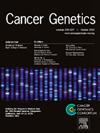Potential use of SCAT1, SCAT2, and SCAT8 as diagnostic and prognosis markers in colorectal cancer
IF 1.4
4区 医学
Q4 GENETICS & HEREDITY
引用次数: 0
Abstract
Colorectal cancer (CRC) is the third most common malignancy and the second leading cause of cancer-related deaths worldwide. Despite advancements, the underlying mechanisms controlling CRC's etiology remain unclear, and reliable biomarkers for diagnosis and treatment are still lacking. Long noncoding RNAs (lncRNAs) are increasingly recognized for their role in cancer progression, though many remain unidentified and their functions poorly understood. In this study, we investigated the expression of SCAT1, SCAT2, and SCAT8 lncRNAs in both cancerous and adjacent non-cancerous tissues from CRC patients. Using cDNA synthesized from total RNA extracted from 100 tissue samples, we performed Real-Time PCR to measure the expression levels of these lncRNAs. In addition, their diagnostic potential was evaluated through ROC curve analysis. Our results demonstrate that SCAT1, SCAT2, and SCAT8 are significantly upregulated in CRC tissues, with ROC analysis suggesting SCAT1 as a moderate biomarker and SCAT2 and SCAT8 as promising biomarkers for CRC diagnosis. Moreover, we found strong correlations between SCAT1 and SCAT8, as well as SCAT2 and SCAT8. Collectively, our findings indicate that SCAT1, SCAT2, and SCAT8 may act as oncogenes in CRC, offering potential as novel biomarkers for diagnosis and prognosis.
SCAT1、SCAT2 和 SCAT8 作为结直肠癌诊断和预后标记物的潜在用途
结直肠癌(CRC)是全球第三大最常见的恶性肿瘤,也是导致癌症相关死亡的第二大原因。尽管研究取得了进展,但控制结直肠癌病因的基本机制仍不清楚,诊断和治疗的可靠生物标志物也仍然缺乏。长非编码 RNA(lncRNA)在癌症进展中的作用日益得到认可,但许多长非编码 RNA 仍未被发现,其功能也鲜为人知。在这项研究中,我们调查了 SCAT1、SCAT2 和 SCAT8 lncRNAs 在 CRC 患者癌组织和邻近非癌组织中的表达情况。利用从 100 份组织样本中提取的总 RNA 合成的 cDNA,我们进行了 Real-Time PCR 检测这些 lncRNA 的表达水平。此外,我们还通过 ROC 曲线分析评估了它们的诊断潜力。我们的结果表明,SCAT1、SCAT2 和 SCAT8 在 CRC 组织中明显上调,ROC 分析表明 SCAT1 是中度生物标志物,SCAT2 和 SCAT8 是有希望用于 CRC 诊断的生物标志物。此外,我们还发现 SCAT1 和 SCAT8 以及 SCAT2 和 SCAT8 之间存在很强的相关性。总之,我们的研究结果表明,SCAT1、SCAT2 和 SCAT8 可能是 CRC 的致癌基因,有望成为诊断和预后的新型生物标记物。
本文章由计算机程序翻译,如有差异,请以英文原文为准。
求助全文
约1分钟内获得全文
求助全文
来源期刊

Cancer Genetics
ONCOLOGY-GENETICS & HEREDITY
CiteScore
3.20
自引率
5.30%
发文量
167
审稿时长
27 days
期刊介绍:
The aim of Cancer Genetics is to publish high quality scientific papers on the cellular, genetic and molecular aspects of cancer, including cancer predisposition and clinical diagnostic applications. Specific areas of interest include descriptions of new chromosomal, molecular or epigenetic alterations in benign and malignant diseases; novel laboratory approaches for identification and characterization of chromosomal rearrangements or genomic alterations in cancer cells; correlation of genetic changes with pathology and clinical presentation; and the molecular genetics of cancer predisposition. To reach a basic science and clinical multidisciplinary audience, we welcome original full-length articles, reviews, meeting summaries, brief reports, and letters to the editor.
 求助内容:
求助内容: 应助结果提醒方式:
应助结果提醒方式:


